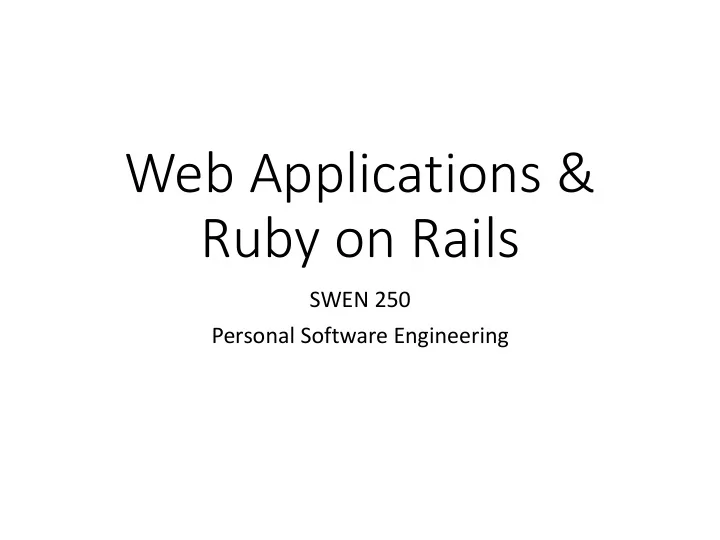

Web Applications & Ruby on Rails SWEN 250 Personal Software Engineering
How Websites Work • Browsers send HTTP requests to a Server • Servers send back HTTP responses • HTTP requests & responses are newline-delimited strings with: • Queries, parameters, body • Metadata (e.g. headers) • Main requests: GET and POST. • Thus: Web servers are just fancy string processors
Example HTTP Requests • GET requests are when you click a link (the vast majority of HTTP requests are GET) http://www.example.com?p1=arg&p2=arg2 • May have query parameters in the URL: • GET /hello.htm HTTP/1.1 User-Agent: Mozilla/4.0 (compatible; MSIE5.01; Windows NT) Host: www.se.rit.edu/~swen-250 Accept-Language: en-us Accept-Encoding: gzip, deflate Connection: Keep-Alive • POST requests are when you request data be modify data on the server
A Typical Web App Flow 1. User types in a URL to a website, ourexample.com i.e. HTTP GET request to ourexample.com 2. Server responds with an HTTP response and HTML data. 3. Browser parses the HTML, page starts loading i.e. Browser parses HTTP response, renders HTML, forms new GET requests for images (<img src=url>), CSS, Javascript, advertisements, and all the other assets – rendering those as they come in. 4. User sees login screen i.e. an HTML form, <form action=“/login”> Username: <input type=“text” name=“username”> Password: <input type =“password” name =“password”> </form> 5. User enters password and hits “Login” ie . An HTTP POST request goes to ourexample.com, with page “/login” and parameters “username” and “password”. 6. User sees their home page i.e. webapp checks password, determines which page to render next
But how does the server work? • A web server will need to • Know what to do at each page • Get and store data in a persistent way • Handle concurrency • Track user flow from one request to another (i.e. HTTP by itself is stateless ) • etc. etc. etc. • Web applications are typically built within frameworks that do most of the HTTP, Database, and even HTML work for you • Ruby on Rails, Django, Express.js, Struts, Play, Spring, etc.
Most WebApps Use Database Model-View-Controller Models Router internet Controller Views use sparingly!!
MVC Purposes • Models handle persistence • Handle queries, storage, CRUD (Create, Read, Update, Delete), transactions, data integrity • Views handle presentation • Arranging outputs in HTML, CSS, Js, responsive design, • A view can also be simply an API call accessible via HTTP requests (e.g. REST) • Controllers handle logic (aka “business logic”) • Routing, behavior, authentication, which queries to call • Glues everything together
MVC with Ruby on Rails • Models: ActiveRecord • Object-relational mapper • Construct SQL queries based on Ruby methods • e.g. a Thought object represents a row in the thoughts table. • Views: ERB templates • Embed Ruby into HTML • Look for the <% %> and <%= %> • Controllers: Ruby Classes • Pages Methods • Render views: respond_to • Routing: routes.rb
Key Rails facts for SWEN 250 • We are running on Windows , not nitron. • Install your app via the z: drive in your folder so you can still commit. • Use PuTTY for Git, use Windows cmd for rails server • You must do this in the lab. If you choose to install Rails on your home machine, you are on your own.
Recommend
More recommend